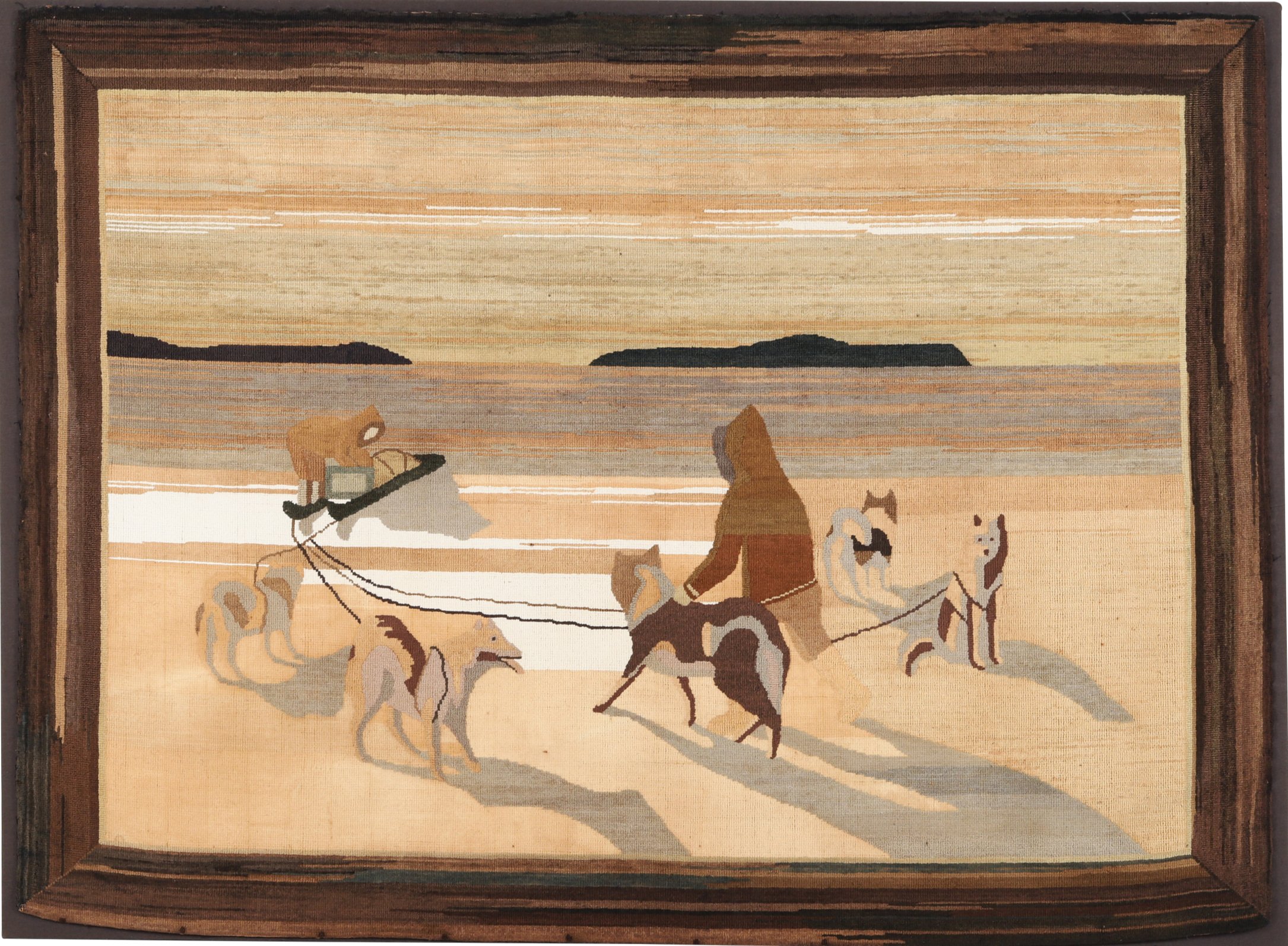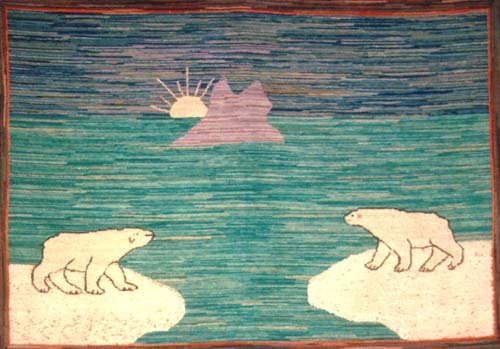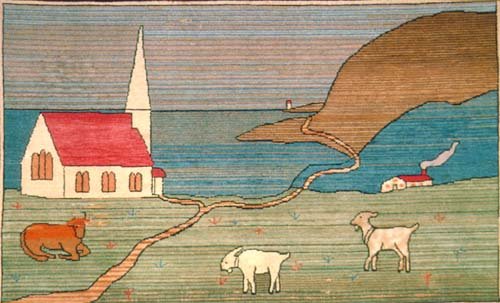From rugs to riches: The hooked mats of the Grenfell Mission
“When your stockings run, let them run to Labrador!”
Canadiana Consignment Director Joe Tuer poses with an original Grenfell Mission hooked mat which sold at Miller & Miller’s February 10th auction.
“Our appreciation of folk art will strengthen our identities, our pride in belonging to a community. People trained in the creative use of their hands soon acquire skills, excellent craftsmanship which will be the most important measure of how well we can industrialize.” - F. Sionil José.
The auction gallery was buzzing with activity earlier this year as the Miller & Miller team prepared a diverse lineup of folk art carvings, sculptures, paintings, and artifacts for the February 10th and 11th sale weekend. Included in the offering was a curation of handcrafted rugs, or "hooked mats," each telling a unique story through charming folk art symbolism and imagery. One particular mat, depicting a dog sledding scene, stood out in the assortment. In an art style that resembles a painted canvas, it featured a layered winter landscape in a soft, muted palette, with shadows casting across the snow banks. It was, unmistakably, a Grenfell hooked mat—and it hammered down at $4,750.
An original Grenfell hooked mat was offered as lot 122 in Miller & Miller’s February 10th auction of Canadiana. It sold for $5,605 (including buyer’s premium).
In stark contrast to the vibrant and colourful maritime coast we're familiar with today, the desolate, rugged landscape of northern Newfoundland and Labrador in the late 19th century told a different story. Life was harsh—marred by poverty, disease, and isolation. Communities grappled with these challenges, lacking proper medical care, education, or basic resources. Often overlooked and cast aside, the region was destined for despair - until the opportune arrival of British medical missionary Wilfred Grenfell in 1892. Amidst the unforgiving coastline, Grenfell uncovered remarkable hope, resilience, and talent woven into the fabric of the neglected coastal community.
Wilfred Grenfell, ca. 1910. Source.
Grenfell’s journey began in 1889 when he set sail to North America, intending to conduct a survey for the United Kingdom's National Mission to Deep Sea Fishermen. However, fate had different plans for Grenfell. He spent that summer sailing along the Labrador coast on a medical vessel treating approximately 900 people for various ailments. Struck by the pervasive poverty and lack of medical resources, Grenfell opted to spend the next year raising funds in St. John's and England to help establish regular healthcare services. These efforts exceeded the scope and resources of the Mission to Deep Sea Fishermen, prompting Grenfell to take matters into his own hands by founding the Grenfell Mission (later renamed the International Grenfell Association).
Grenfell returned to Labrador the following summer with a team of physicians and nurses, and together they opened a hospital in Battle Harbour and began the construction of another in nearby Indian Harbour. The team also acquired a second medical boat to expand services to fishing stations and remote coastal communities. His efforts were graciously accepted by the region’s inhabitants, inspiring Grenfell to broaden his vision.
Battle Harbour Hospital, pre-1930. Source.
Acknowledging the untapped potential of the community, Grenfell aimed to spark social change through education, agriculture, and industrial development. He soon enlisted large numbers of mission workers, among them prominent figures such as future New York governor Nelson Rockefeller and the children of rubber manufacturer B.F. Goodrich. As the team grew, so did the impact. In the years following, the Grenfell Mission established numerous hospitals, schools, lumber mills, community farms and co-operative stores. These initiatives boosted the economic stability of the region and greatly enhanced the quality of life for the people. Yet, it was an age-old hobby skill well-known to the women of the region that gained surprising momentum—mat hooking.
Rooted in the traditions of the founding English and Scottish settlers, mat hooking was a generational craft practiced by the women of Newfoundland and Labrador from childhood. In 1905, Grenfell met Jessie Luther, an American woman skilled in using crafts as part of medical treatment. He invited Luther to the Labrador region with the goal of establishing a weaving project, providing local women with an opportunity to supplement their family income. Despite initial resistance from the region’s women who were hesitant to take direction on their time-honoured craft, Luther's innovative approach bridged traditional knowledge with commercial viability, transforming mat hooking into a legitimate industry.
Working together with the Grenfell Mission, Luther designed a production process that revolutionized the craft. Mat workers, dispersed along the rocky Labrador coast, received kits consisting of mission-approved designs drawn on burlap, locally known as "brin," and the necessary hooking materials. The designs featured local motifs such as deer, seals, polar bears, sled dogs, and coastal landscapes, encapsulating the beauty and essence of Newfoundland and Labrador. The mat offered in the upcoming auction features a design known as Shadows, by artist Stephen Hamilton who spent several years at the Grenfell Mission. The image depicts an expedition where a komatik (dog sled) was used to bridge a gap in the ice. The clever use of depth and shadows provides an immersive glimpse into the Labrador lifestyle.



Pictured above: Photo 1: "Shadows”, which sold for $5,605 (including buyer’s premium) at Miller & Miller’s February 10th auction. Photo 2 & 3: Source.
As mat workers completed their pieces, mission workers would travel along the coast to evaluate the craftsmanship, pay the makers, and collect the mats. At first, the income barely covered essential needs such as clothing and medicine, but as the industry grew, women could buy more with their "mat money,” instilling a newfound sense of pride within the women of the region.
The mission held mat sales in New England and New York, and opened retail shops in New York City and Philadelphia. Initially crafted from conventional cotton and wool materials, it wasn't until the introduction of silk in the late 1920s when the mats experienced a major surge in popularity. Like most well-received products, balancing supply and demand quickly became a challenge.
In 1928, Grenfell’s Industrial Supervisor M.A. Pressley-Smith issued a plea through the mission’s quarterly publication, Among the Deep Sea Fishers: "Save Your Old Silk Stockings! When your stockings run, let them run to Labrador!” The advertisement urged readers to send in old silk stockings and underwear for repurposing in the mats, a clever strategy that provided a sustainable material source while also fostering community involvement. At its peak, the mission received over 10 tons of silk in one year.
Unfortunately, success soon began to unravel at the seams. As the Great Depression set in, a decline in mat sales, coupled with a surplus of mats and a lack of new markets, posed significant difficulties for the mission. In 1932, the fish catch failed and nearly 20,000 people were left on meagre government relief as the mission's supplies and resources were depleted. After Grenfell's death in 1940, the program had lost not only its resources, but also its spirit.
Today, the original Grenfell hooked mats are highly sought-after by collectors of folk art and Canadiana. While standing the test of time as incredible works of art, the mats also embody the ingenuity and craftsmanship that remains deeply woven into the fabric of Newfoundland and Labrador's cultural history.
Story by Tess Malloy
Tess is a freelance writer and history enthusiast who enjoys unearthing interesting stories about remarkable people and objects. Tess has written for The Miller Times for six years.
SALE DETAILS:
Canadiana
The Richardson, Blevins, Morawetz & Molson Foundation Collections
February 10, 2024
9am EST





